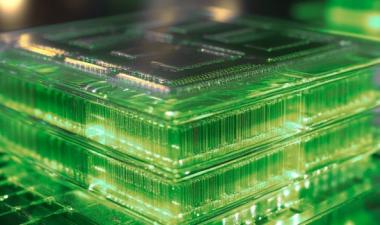Sustainable Semiconductor Manufacturing: A Mid-Year Roundup of 2024 Top Developments
The first half of 2024 has witnessed significant strides in the quest for a more sustainable semiconductor manufacturing industry. With increasing pressure from environmental regulations, consumer demand, and investor scrutiny, chipmakers are actively exploring innovative solutions to reduce their environmental footprint.
Let's dive into five developments in sustainable chip manufacturing from the first half of 2024:
1. Renewables Take Center Stage: Chipmakers Embrace Clean Energy
One of the most significant trends has been the growing commitment to renewable energy adoption.
- TSMC's Ambitious Renewable Shift: In February 2024, Taiwan Semiconductor Manufacturing Company (TSMC), the world's largest foundry, announced a groundbreaking deal. They signed the world's largest corporate renewable energy power purchase agreement (PPA) with a company building a 920-megawatt offshore wind farm in the Taiwan Strait. This move is expected to provide TSMC with 25% of its electricity needs by 2026, significantly reducing its reliance on fossil fuels.
- Chipmaker Commits to Net Zero Emissions, Carbon-Neutral Power by 2050: In April 2024, GlobalFoundries increased its commitment to sustainable operations by announcing two new long-term goals to achieve net-zero greenhouse gas emissions and 100% carbon-neutral power by 2050.
2. Water Conservation Efforts: Recycling and Innovation on the Rise
Water scarcity is a major concern in sustainable chip manufacturing. Here are two 2024 advancements tackling this challenge:
- EU's Stricter Water Usage Regulations: The European Union (EU) is pushing for stricter environmental regulations on chip manufacturing. In June 2024, the EU proposed new legislation that would set stricter limits on water usage and mandate the adoption of water recycling technologies for semiconductor fabs operating within the bloc. These regulations are expected to incentivize further innovation in water conservation practices.
- GlobalFoundries' Water Recycling Breakthrough: In March 2024, GlobalFoundries, a manufacturer of advanced semiconductors, announced a breakthrough in wastewater treatment technology. Its new system utilizes a combination of advanced filtration and membrane separation techniques to achieve a 98% recycling rate for process water. This innovation has the potential to significantly reduce water consumption in chip fabs.
3. Lifecycle Assessments (LCAs) Gain Traction: Transparency in Environmental Impact
Transparency is crucial for sustainable practices. Here's how life cycle assessments are playing a role:
- Industry-Wide LCA Standardization Efforts: The increasing demand for transparency in the environmental impact of electronics has led to a push for standardized LCA methodologies in the semiconductor industry. The International Electronics Manufacturing Initiative (iNEMI) launched a working group in May 2024 to develop a comprehensive LCA framework specifically for semiconductor manufacturing. This standardization will enable accurate comparisons and informed decision-making throughout the product lifecycle.
- Increased Focus on Sustainable Material Sourcing: Chipmakers are becoming more conscious of the environmental impact of their materials sourcing. Companies, like Intel, are leading the way by announcing partnerships with suppliers committed to responsible mining practices and recycled materials in their supply chains. Additionally, research into alternative materials with lower environmental footprints is gaining momentum.
4. Collaboration for Sustainable Design: Chipmakers & Designers Join Forces
Collaboration across the industry value chain is key to achieving major sustainability goals. Here's how chip designers and manufacturers are working together:
- Focus on Energy-Efficient Chip Architectures: Leading chip designers are increasingly focusing on developing architectures that prioritize energy efficiency. This includes exploring new techniques like low-power transistors, reduced clock speeds, and power gating technologies. These advancements can significantly reduce the energy consumption of electronic devices throughout their lifespan.
5. Regulatory Landscape Shifts: Governments Push for Sustainable Practices
Governments around the world are enacting stricter environmental regulations to push for a more sustainable semiconductor industry. Here are two key developments:
- The U.S. CHIPS Act and Sustainability Provisions: The CHIPS Act, a landmark piece of U.S. legislation passed in May 2024, includes provisions promoting sustainable chip manufacturing. It allocates funding for research and development of clean energy technologies for chip fabs and incentivizes companies to adopt sustainable practices.
- China's Green Manufacturing Push: This initiative has major implications for the nation's vast tech sector and the global semiconductor industry. Recognizing the urgency of environmental issues, the Chinese government has embarked on an ambitious green manufacturing initiative. The program includes stricter government-enacted environmental laws with heavier penalties for non-compliance and policies promoting a circular economy.

For an even more comprehensive mid-2024 recap, here’s a look back at some of the top Sustainability stories and topics covered by TechInsights’ analysts and experts.
- A Tale of Three Phone Chips-Eco Edition: We perform a preliminary emissions analysis of three processors used in today’s flagship phones from Apple, Huawei and Samsung. While process node, fab location, and abatement efficiency have a strong impact on semiconductor carbon footprint, our review found die size has a more significant impact on the processors we evaluated.
- Taiwan’s Green Energy Conundrum – Balancing Increasing Demand with Sustainability Targets: Taiwan has set ambitious net-zero emissions targets and is gradually on its way to achieving them. But with limited natural resources and access to renewable energy sources, there are questions remaining whether these recent sustainability gains are enough.
- SEC Court Challenge Sidetracks Emissions Reporting Requirements: The U.S. Securities and Exchange Commission (SEC) announces that they will be pausing implementation of its new climate disclosure rules while they defend them against legal challenges is further evidence of how difficult it is for companies to perform full cradle-to-grave emissions analysis and how motivated some might be to resist.
- Apple M4 Release Charting Progress Towards Sustainability Goals: Apple’s release announcement highlights several developments from a sustainability perspective, reiterating the aim to be “carbon neutral across the entire manufacturing supply chain and life cycle of every product by 2030.”
- Can AI Microprocessors be Sustainable? New NVIDIA Blackwell Chip Points to a Breakthrough for High Tech Industry: Nvidia’s announcement of the anticipated Blackwell Hopper series of GPUs has tech leaders salivating to get their hands on these new chips. The claim that they will run with far less energy consumption sounds like a giant step forward for semiconductors becoming more efficient and sustainable.
- PFAS in Semiconductor Manufacturing: A Major Sustainability Challenge: Amid the development of the next generation of silicon chips and integrated circuits lies a silent challenge: the pervasive use of per- and polyfluoroalkyl substances (PFAS). These chemicals, renowned for their resistance to heat, water, and oil, have found their way into various industrial processes, including semiconductor manufacturing. But at what cost?













